The Influence of Precariousness on HRM Decision Making Report
VerifiedAdded on 2023/03/20
|8
|2118
|74
Report
AI Summary
This report delves into the impact of precariousness on human resource management (HRM) decision-making in Australia. It explores how non-standard employment practices, characterized by uncertainty and risk, influence various aspects of HRM. The report examines the increasing prevalence of precarious work, its effects on job security, and the implications for workers' well-being, including mental and physical health outcomes. It analyzes how precariousness affects recruitment processes, employee engagement, and the overall labor market dynamics. The paper also discusses the benefits organizations gain from precarious employment, such as reduced costs and flexibility, while highlighting the negative consequences for employees. The report concludes that while precariousness offers certain advantages to employers, it poses significant challenges to employee satisfaction and security, emphasizing the need for policies that balance organizational needs with worker protection and well-being. The study uses data from HILDA survey and other research to support its claims.
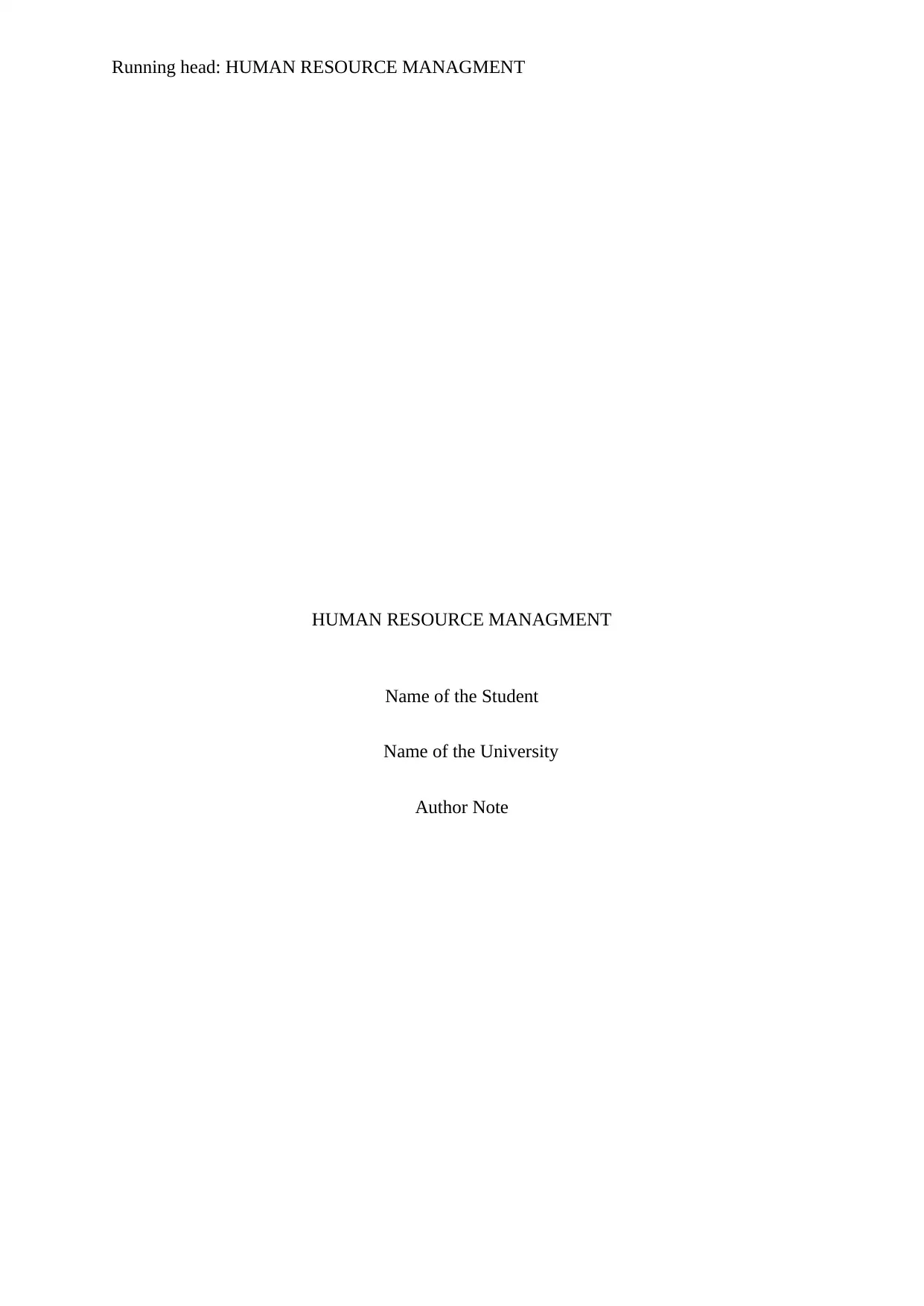
Running head: HUMAN RESOURCE MANAGMENT
HUMAN RESOURCE MANAGMENT
Name of the Student
Name of the University
Author Note
HUMAN RESOURCE MANAGMENT
Name of the Student
Name of the University
Author Note
Paraphrase This Document
Need a fresh take? Get an instant paraphrase of this document with our AI Paraphraser
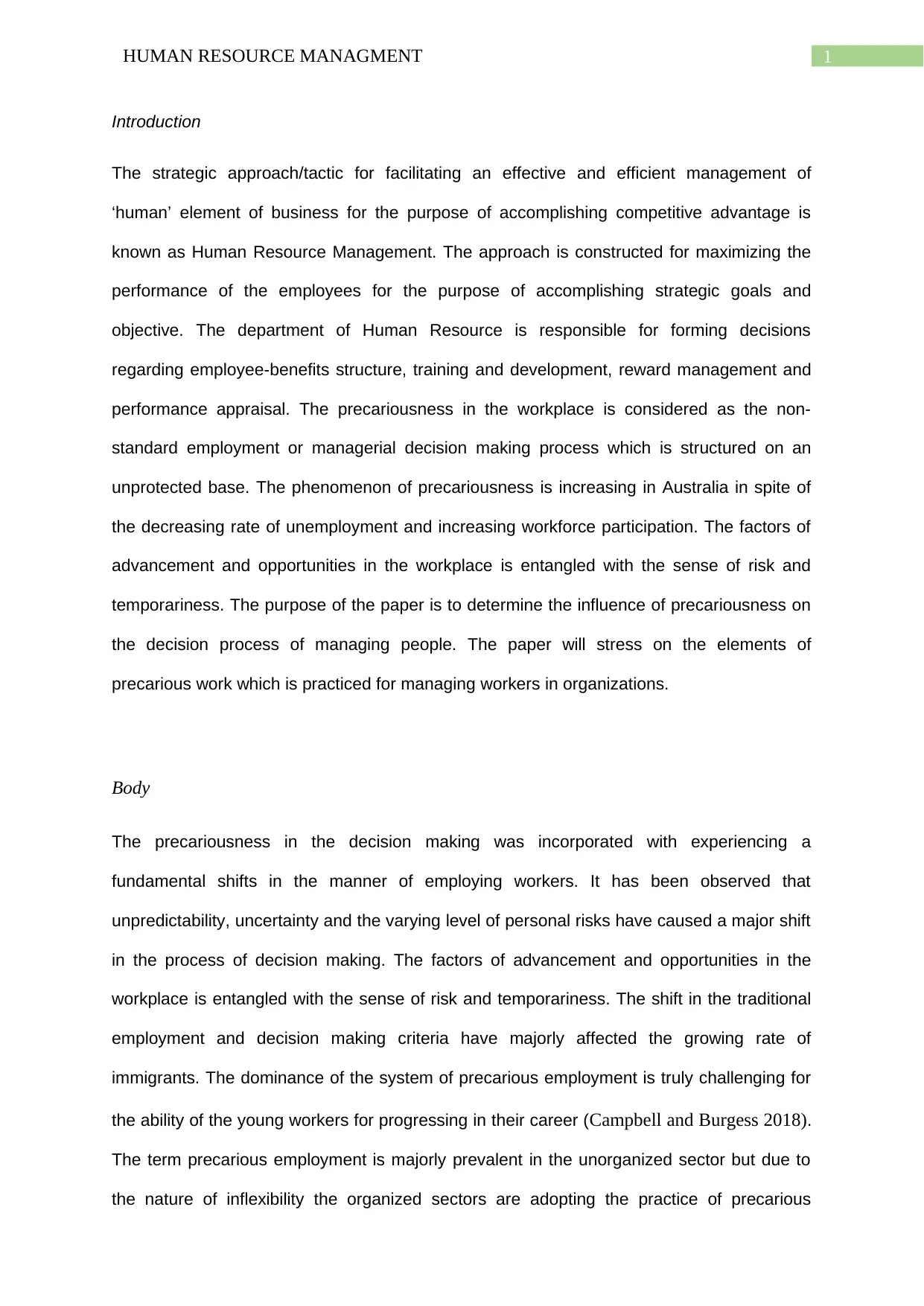
1HUMAN RESOURCE MANAGMENT
Introduction
The strategic approach/tactic for facilitating an effective and efficient management of
‘human’ element of business for the purpose of accomplishing competitive advantage is
known as Human Resource Management. The approach is constructed for maximizing the
performance of the employees for the purpose of accomplishing strategic goals and
objective. The department of Human Resource is responsible for forming decisions
regarding employee-benefits structure, training and development, reward management and
performance appraisal. The precariousness in the workplace is considered as the non-
standard employment or managerial decision making process which is structured on an
unprotected base. The phenomenon of precariousness is increasing in Australia in spite of
the decreasing rate of unemployment and increasing workforce participation. The factors of
advancement and opportunities in the workplace is entangled with the sense of risk and
temporariness. The purpose of the paper is to determine the influence of precariousness on
the decision process of managing people. The paper will stress on the elements of
precarious work which is practiced for managing workers in organizations.
Body
The precariousness in the decision making was incorporated with experiencing a
fundamental shifts in the manner of employing workers. It has been observed that
unpredictability, uncertainty and the varying level of personal risks have caused a major shift
in the process of decision making. The factors of advancement and opportunities in the
workplace is entangled with the sense of risk and temporariness. The shift in the traditional
employment and decision making criteria have majorly affected the growing rate of
immigrants. The dominance of the system of precarious employment is truly challenging for
the ability of the young workers for progressing in their career (Campbell and Burgess 2018).
The term precarious employment is majorly prevalent in the unorganized sector but due to
the nature of inflexibility the organized sectors are adopting the practice of precarious
Introduction
The strategic approach/tactic for facilitating an effective and efficient management of
‘human’ element of business for the purpose of accomplishing competitive advantage is
known as Human Resource Management. The approach is constructed for maximizing the
performance of the employees for the purpose of accomplishing strategic goals and
objective. The department of Human Resource is responsible for forming decisions
regarding employee-benefits structure, training and development, reward management and
performance appraisal. The precariousness in the workplace is considered as the non-
standard employment or managerial decision making process which is structured on an
unprotected base. The phenomenon of precariousness is increasing in Australia in spite of
the decreasing rate of unemployment and increasing workforce participation. The factors of
advancement and opportunities in the workplace is entangled with the sense of risk and
temporariness. The purpose of the paper is to determine the influence of precariousness on
the decision process of managing people. The paper will stress on the elements of
precarious work which is practiced for managing workers in organizations.
Body
The precariousness in the decision making was incorporated with experiencing a
fundamental shifts in the manner of employing workers. It has been observed that
unpredictability, uncertainty and the varying level of personal risks have caused a major shift
in the process of decision making. The factors of advancement and opportunities in the
workplace is entangled with the sense of risk and temporariness. The shift in the traditional
employment and decision making criteria have majorly affected the growing rate of
immigrants. The dominance of the system of precarious employment is truly challenging for
the ability of the young workers for progressing in their career (Campbell and Burgess 2018).
The term precarious employment is majorly prevalent in the unorganized sector but due to
the nature of inflexibility the organized sectors are adopting the practice of precarious
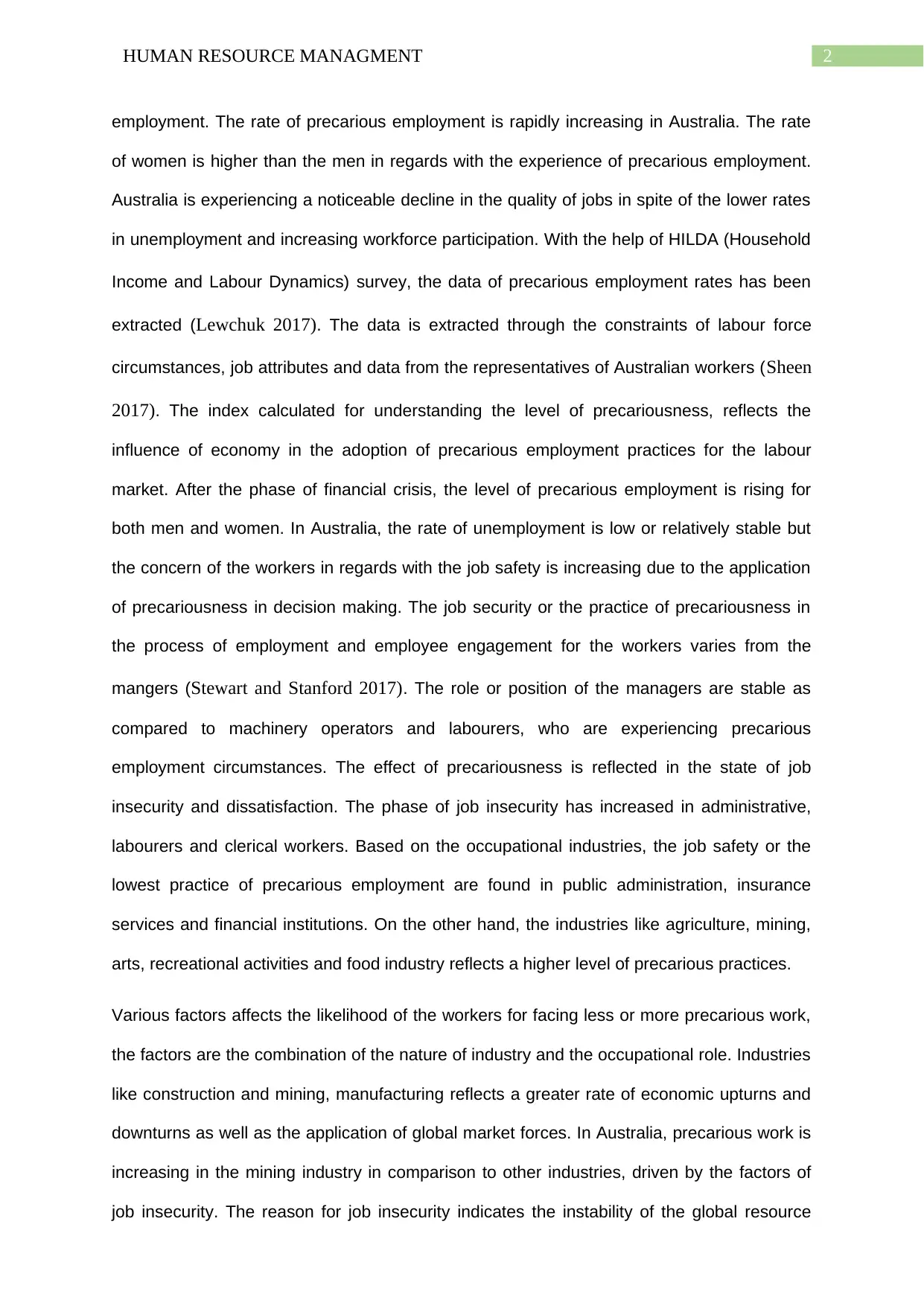
2HUMAN RESOURCE MANAGMENT
employment. The rate of precarious employment is rapidly increasing in Australia. The rate
of women is higher than the men in regards with the experience of precarious employment.
Australia is experiencing a noticeable decline in the quality of jobs in spite of the lower rates
in unemployment and increasing workforce participation. With the help of HILDA (Household
Income and Labour Dynamics) survey, the data of precarious employment rates has been
extracted (Lewchuk 2017). The data is extracted through the constraints of labour force
circumstances, job attributes and data from the representatives of Australian workers (Sheen
2017). The index calculated for understanding the level of precariousness, reflects the
influence of economy in the adoption of precarious employment practices for the labour
market. After the phase of financial crisis, the level of precarious employment is rising for
both men and women. In Australia, the rate of unemployment is low or relatively stable but
the concern of the workers in regards with the job safety is increasing due to the application
of precariousness in decision making. The job security or the practice of precariousness in
the process of employment and employee engagement for the workers varies from the
mangers (Stewart and Stanford 2017). The role or position of the managers are stable as
compared to machinery operators and labourers, who are experiencing precarious
employment circumstances. The effect of precariousness is reflected in the state of job
insecurity and dissatisfaction. The phase of job insecurity has increased in administrative,
labourers and clerical workers. Based on the occupational industries, the job safety or the
lowest practice of precarious employment are found in public administration, insurance
services and financial institutions. On the other hand, the industries like agriculture, mining,
arts, recreational activities and food industry reflects a higher level of precarious practices.
Various factors affects the likelihood of the workers for facing less or more precarious work,
the factors are the combination of the nature of industry and the occupational role. Industries
like construction and mining, manufacturing reflects a greater rate of economic upturns and
downturns as well as the application of global market forces. In Australia, precarious work is
increasing in the mining industry in comparison to other industries, driven by the factors of
job insecurity. The reason for job insecurity indicates the instability of the global resource
employment. The rate of precarious employment is rapidly increasing in Australia. The rate
of women is higher than the men in regards with the experience of precarious employment.
Australia is experiencing a noticeable decline in the quality of jobs in spite of the lower rates
in unemployment and increasing workforce participation. With the help of HILDA (Household
Income and Labour Dynamics) survey, the data of precarious employment rates has been
extracted (Lewchuk 2017). The data is extracted through the constraints of labour force
circumstances, job attributes and data from the representatives of Australian workers (Sheen
2017). The index calculated for understanding the level of precariousness, reflects the
influence of economy in the adoption of precarious employment practices for the labour
market. After the phase of financial crisis, the level of precarious employment is rising for
both men and women. In Australia, the rate of unemployment is low or relatively stable but
the concern of the workers in regards with the job safety is increasing due to the application
of precariousness in decision making. The job security or the practice of precariousness in
the process of employment and employee engagement for the workers varies from the
mangers (Stewart and Stanford 2017). The role or position of the managers are stable as
compared to machinery operators and labourers, who are experiencing precarious
employment circumstances. The effect of precariousness is reflected in the state of job
insecurity and dissatisfaction. The phase of job insecurity has increased in administrative,
labourers and clerical workers. Based on the occupational industries, the job safety or the
lowest practice of precarious employment are found in public administration, insurance
services and financial institutions. On the other hand, the industries like agriculture, mining,
arts, recreational activities and food industry reflects a higher level of precarious practices.
Various factors affects the likelihood of the workers for facing less or more precarious work,
the factors are the combination of the nature of industry and the occupational role. Industries
like construction and mining, manufacturing reflects a greater rate of economic upturns and
downturns as well as the application of global market forces. In Australia, precarious work is
increasing in the mining industry in comparison to other industries, driven by the factors of
job insecurity. The reason for job insecurity indicates the instability of the global resource
⊘ This is a preview!⊘
Do you want full access?
Subscribe today to unlock all pages.

Trusted by 1+ million students worldwide
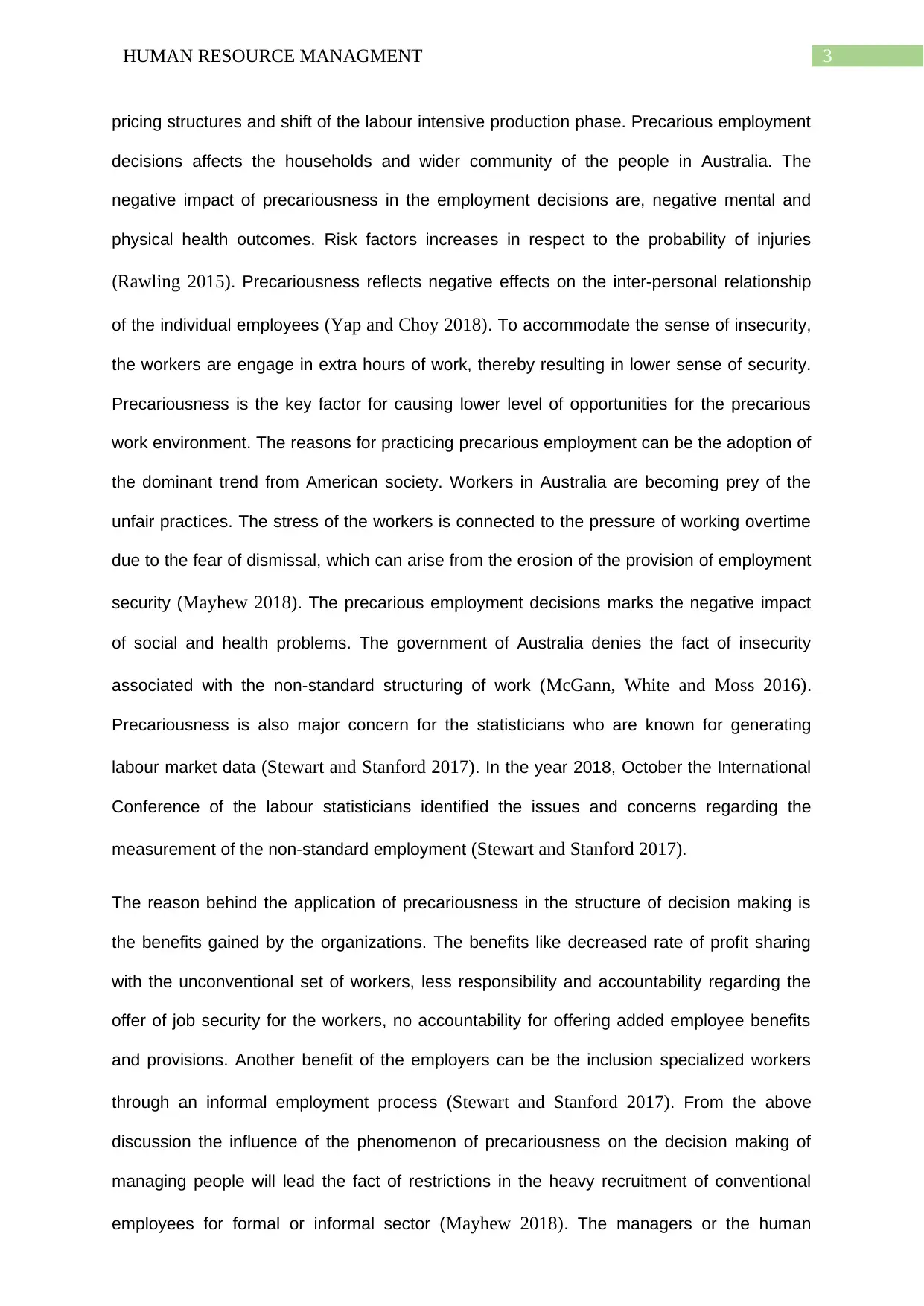
3HUMAN RESOURCE MANAGMENT
pricing structures and shift of the labour intensive production phase. Precarious employment
decisions affects the households and wider community of the people in Australia. The
negative impact of precariousness in the employment decisions are, negative mental and
physical health outcomes. Risk factors increases in respect to the probability of injuries
(Rawling 2015). Precariousness reflects negative effects on the inter-personal relationship
of the individual employees (Yap and Choy 2018). To accommodate the sense of insecurity,
the workers are engage in extra hours of work, thereby resulting in lower sense of security.
Precariousness is the key factor for causing lower level of opportunities for the precarious
work environment. The reasons for practicing precarious employment can be the adoption of
the dominant trend from American society. Workers in Australia are becoming prey of the
unfair practices. The stress of the workers is connected to the pressure of working overtime
due to the fear of dismissal, which can arise from the erosion of the provision of employment
security (Mayhew 2018). The precarious employment decisions marks the negative impact
of social and health problems. The government of Australia denies the fact of insecurity
associated with the non-standard structuring of work (McGann, White and Moss 2016).
Precariousness is also major concern for the statisticians who are known for generating
labour market data (Stewart and Stanford 2017). In the year 2018, October the International
Conference of the labour statisticians identified the issues and concerns regarding the
measurement of the non-standard employment (Stewart and Stanford 2017).
The reason behind the application of precariousness in the structure of decision making is
the benefits gained by the organizations. The benefits like decreased rate of profit sharing
with the unconventional set of workers, less responsibility and accountability regarding the
offer of job security for the workers, no accountability for offering added employee benefits
and provisions. Another benefit of the employers can be the inclusion specialized workers
through an informal employment process (Stewart and Stanford 2017). From the above
discussion the influence of the phenomenon of precariousness on the decision making of
managing people will lead the fact of restrictions in the heavy recruitment of conventional
employees for formal or informal sector (Mayhew 2018). The managers or the human
pricing structures and shift of the labour intensive production phase. Precarious employment
decisions affects the households and wider community of the people in Australia. The
negative impact of precariousness in the employment decisions are, negative mental and
physical health outcomes. Risk factors increases in respect to the probability of injuries
(Rawling 2015). Precariousness reflects negative effects on the inter-personal relationship
of the individual employees (Yap and Choy 2018). To accommodate the sense of insecurity,
the workers are engage in extra hours of work, thereby resulting in lower sense of security.
Precariousness is the key factor for causing lower level of opportunities for the precarious
work environment. The reasons for practicing precarious employment can be the adoption of
the dominant trend from American society. Workers in Australia are becoming prey of the
unfair practices. The stress of the workers is connected to the pressure of working overtime
due to the fear of dismissal, which can arise from the erosion of the provision of employment
security (Mayhew 2018). The precarious employment decisions marks the negative impact
of social and health problems. The government of Australia denies the fact of insecurity
associated with the non-standard structuring of work (McGann, White and Moss 2016).
Precariousness is also major concern for the statisticians who are known for generating
labour market data (Stewart and Stanford 2017). In the year 2018, October the International
Conference of the labour statisticians identified the issues and concerns regarding the
measurement of the non-standard employment (Stewart and Stanford 2017).
The reason behind the application of precariousness in the structure of decision making is
the benefits gained by the organizations. The benefits like decreased rate of profit sharing
with the unconventional set of workers, less responsibility and accountability regarding the
offer of job security for the workers, no accountability for offering added employee benefits
and provisions. Another benefit of the employers can be the inclusion specialized workers
through an informal employment process (Stewart and Stanford 2017). From the above
discussion the influence of the phenomenon of precariousness on the decision making of
managing people will lead the fact of restrictions in the heavy recruitment of conventional
employees for formal or informal sector (Mayhew 2018). The managers or the human
Paraphrase This Document
Need a fresh take? Get an instant paraphrase of this document with our AI Paraphraser
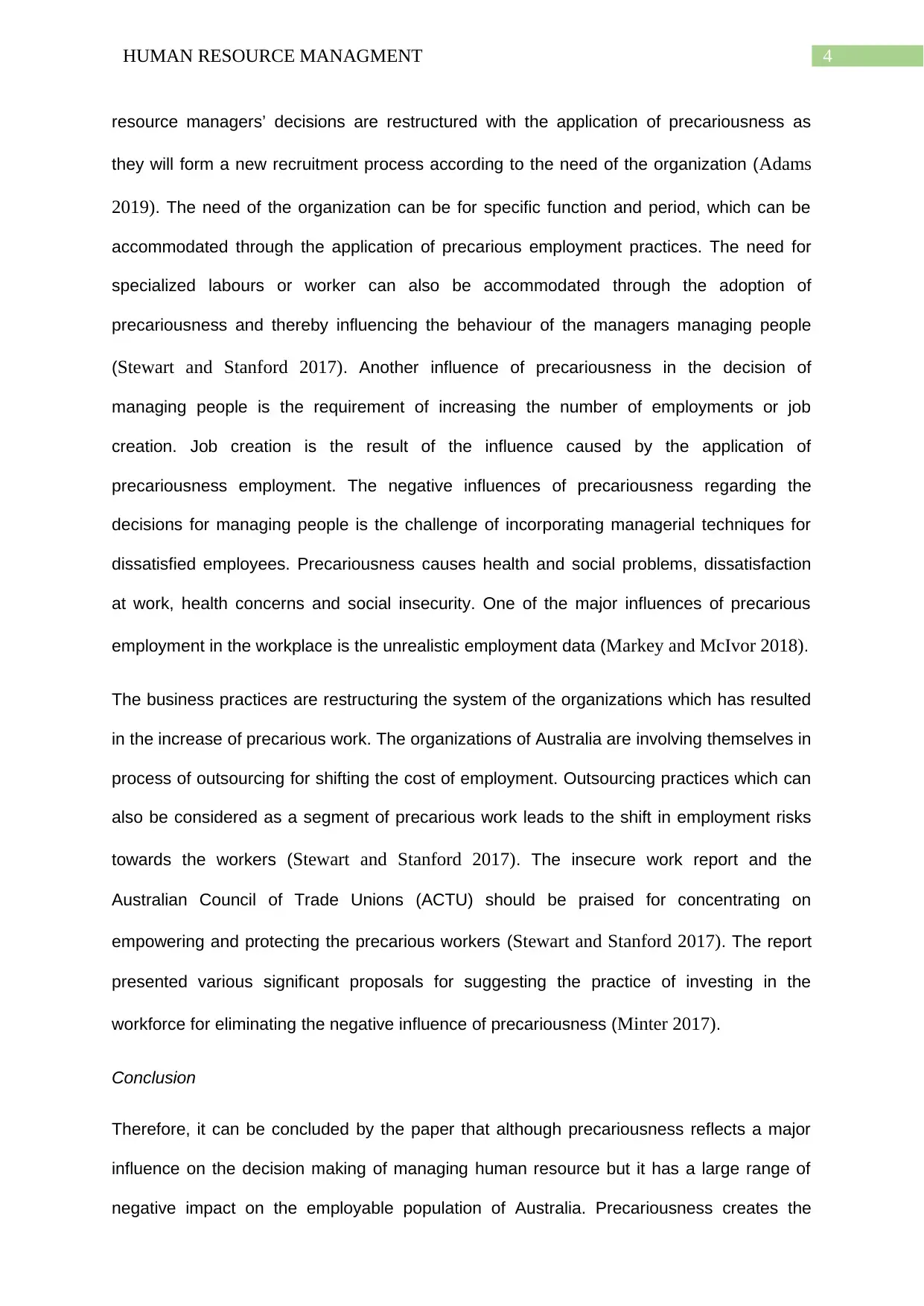
4HUMAN RESOURCE MANAGMENT
resource managers’ decisions are restructured with the application of precariousness as
they will form a new recruitment process according to the need of the organization (Adams
2019). The need of the organization can be for specific function and period, which can be
accommodated through the application of precarious employment practices. The need for
specialized labours or worker can also be accommodated through the adoption of
precariousness and thereby influencing the behaviour of the managers managing people
(Stewart and Stanford 2017). Another influence of precariousness in the decision of
managing people is the requirement of increasing the number of employments or job
creation. Job creation is the result of the influence caused by the application of
precariousness employment. The negative influences of precariousness regarding the
decisions for managing people is the challenge of incorporating managerial techniques for
dissatisfied employees. Precariousness causes health and social problems, dissatisfaction
at work, health concerns and social insecurity. One of the major influences of precarious
employment in the workplace is the unrealistic employment data (Markey and McIvor 2018).
The business practices are restructuring the system of the organizations which has resulted
in the increase of precarious work. The organizations of Australia are involving themselves in
process of outsourcing for shifting the cost of employment. Outsourcing practices which can
also be considered as a segment of precarious work leads to the shift in employment risks
towards the workers (Stewart and Stanford 2017). The insecure work report and the
Australian Council of Trade Unions (ACTU) should be praised for concentrating on
empowering and protecting the precarious workers (Stewart and Stanford 2017). The report
presented various significant proposals for suggesting the practice of investing in the
workforce for eliminating the negative influence of precariousness (Minter 2017).
Conclusion
Therefore, it can be concluded by the paper that although precariousness reflects a major
influence on the decision making of managing human resource but it has a large range of
negative impact on the employable population of Australia. Precariousness creates the
resource managers’ decisions are restructured with the application of precariousness as
they will form a new recruitment process according to the need of the organization (Adams
2019). The need of the organization can be for specific function and period, which can be
accommodated through the application of precarious employment practices. The need for
specialized labours or worker can also be accommodated through the adoption of
precariousness and thereby influencing the behaviour of the managers managing people
(Stewart and Stanford 2017). Another influence of precariousness in the decision of
managing people is the requirement of increasing the number of employments or job
creation. Job creation is the result of the influence caused by the application of
precariousness employment. The negative influences of precariousness regarding the
decisions for managing people is the challenge of incorporating managerial techniques for
dissatisfied employees. Precariousness causes health and social problems, dissatisfaction
at work, health concerns and social insecurity. One of the major influences of precarious
employment in the workplace is the unrealistic employment data (Markey and McIvor 2018).
The business practices are restructuring the system of the organizations which has resulted
in the increase of precarious work. The organizations of Australia are involving themselves in
process of outsourcing for shifting the cost of employment. Outsourcing practices which can
also be considered as a segment of precarious work leads to the shift in employment risks
towards the workers (Stewart and Stanford 2017). The insecure work report and the
Australian Council of Trade Unions (ACTU) should be praised for concentrating on
empowering and protecting the precarious workers (Stewart and Stanford 2017). The report
presented various significant proposals for suggesting the practice of investing in the
workforce for eliminating the negative influence of precariousness (Minter 2017).
Conclusion
Therefore, it can be concluded by the paper that although precariousness reflects a major
influence on the decision making of managing human resource but it has a large range of
negative impact on the employable population of Australia. Precariousness creates the
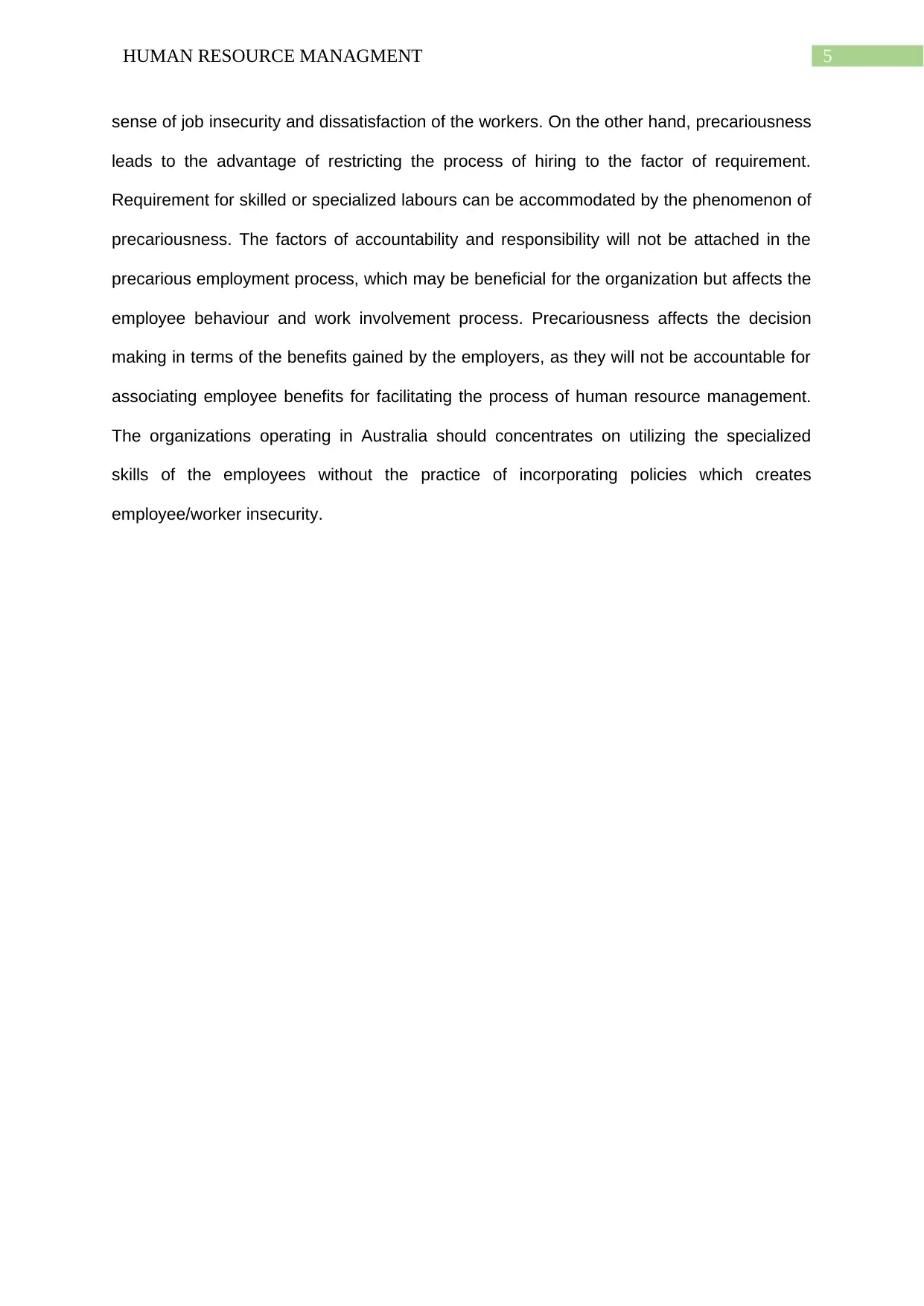
5HUMAN RESOURCE MANAGMENT
sense of job insecurity and dissatisfaction of the workers. On the other hand, precariousness
leads to the advantage of restricting the process of hiring to the factor of requirement.
Requirement for skilled or specialized labours can be accommodated by the phenomenon of
precariousness. The factors of accountability and responsibility will not be attached in the
precarious employment process, which may be beneficial for the organization but affects the
employee behaviour and work involvement process. Precariousness affects the decision
making in terms of the benefits gained by the employers, as they will not be accountable for
associating employee benefits for facilitating the process of human resource management.
The organizations operating in Australia should concentrates on utilizing the specialized
skills of the employees without the practice of incorporating policies which creates
employee/worker insecurity.
sense of job insecurity and dissatisfaction of the workers. On the other hand, precariousness
leads to the advantage of restricting the process of hiring to the factor of requirement.
Requirement for skilled or specialized labours can be accommodated by the phenomenon of
precariousness. The factors of accountability and responsibility will not be attached in the
precarious employment process, which may be beneficial for the organization but affects the
employee behaviour and work involvement process. Precariousness affects the decision
making in terms of the benefits gained by the employers, as they will not be accountable for
associating employee benefits for facilitating the process of human resource management.
The organizations operating in Australia should concentrates on utilizing the specialized
skills of the employees without the practice of incorporating policies which creates
employee/worker insecurity.
⊘ This is a preview!⊘
Do you want full access?
Subscribe today to unlock all pages.

Trusted by 1+ million students worldwide
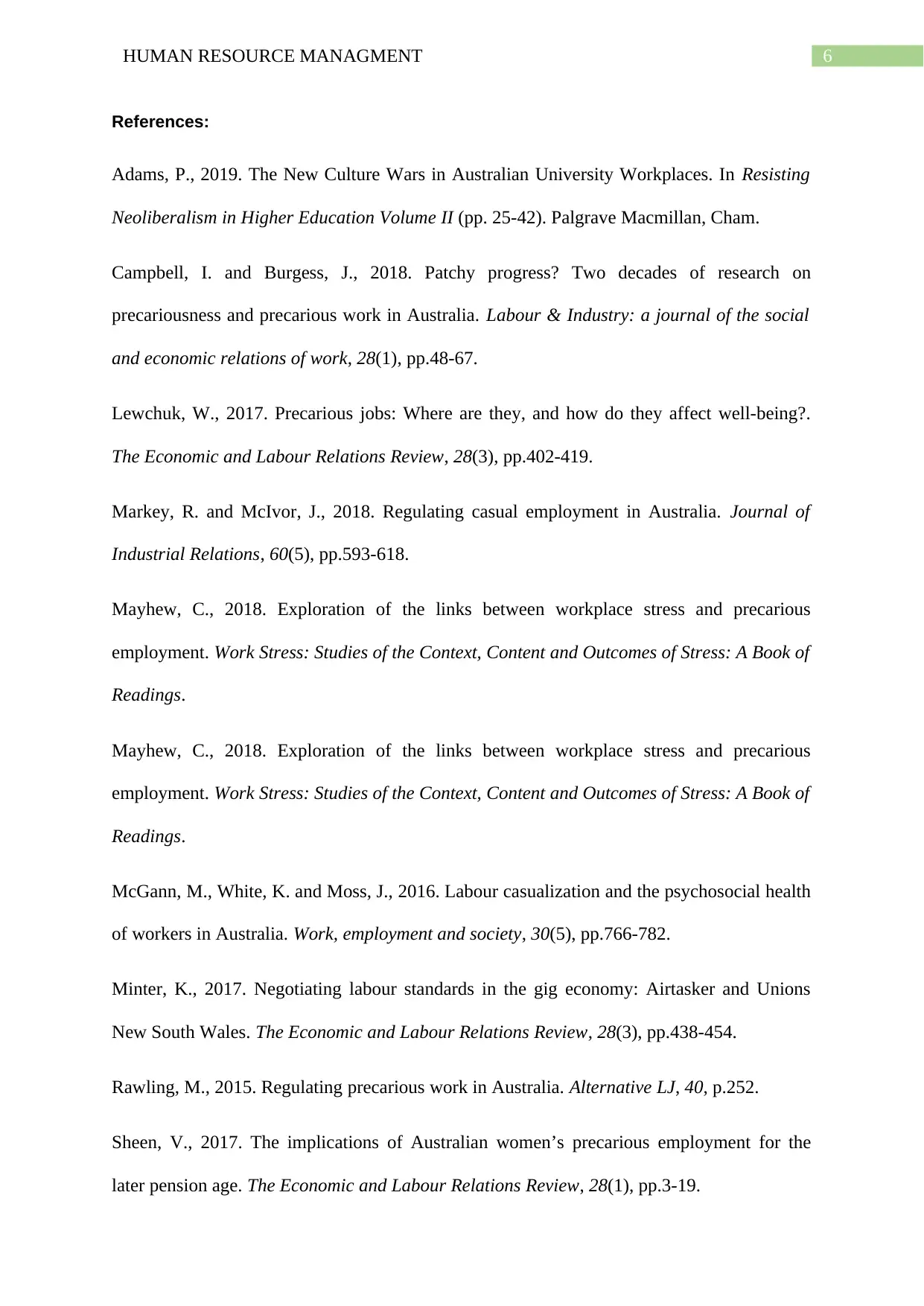
6HUMAN RESOURCE MANAGMENT
References:
Adams, P., 2019. The New Culture Wars in Australian University Workplaces. In Resisting
Neoliberalism in Higher Education Volume II (pp. 25-42). Palgrave Macmillan, Cham.
Campbell, I. and Burgess, J., 2018. Patchy progress? Two decades of research on
precariousness and precarious work in Australia. Labour & Industry: a journal of the social
and economic relations of work, 28(1), pp.48-67.
Lewchuk, W., 2017. Precarious jobs: Where are they, and how do they affect well-being?.
The Economic and Labour Relations Review, 28(3), pp.402-419.
Markey, R. and McIvor, J., 2018. Regulating casual employment in Australia. Journal of
Industrial Relations, 60(5), pp.593-618.
Mayhew, C., 2018. Exploration of the links between workplace stress and precarious
employment. Work Stress: Studies of the Context, Content and Outcomes of Stress: A Book of
Readings.
Mayhew, C., 2018. Exploration of the links between workplace stress and precarious
employment. Work Stress: Studies of the Context, Content and Outcomes of Stress: A Book of
Readings.
McGann, M., White, K. and Moss, J., 2016. Labour casualization and the psychosocial health
of workers in Australia. Work, employment and society, 30(5), pp.766-782.
Minter, K., 2017. Negotiating labour standards in the gig economy: Airtasker and Unions
New South Wales. The Economic and Labour Relations Review, 28(3), pp.438-454.
Rawling, M., 2015. Regulating precarious work in Australia. Alternative LJ, 40, p.252.
Sheen, V., 2017. The implications of Australian women’s precarious employment for the
later pension age. The Economic and Labour Relations Review, 28(1), pp.3-19.
References:
Adams, P., 2019. The New Culture Wars in Australian University Workplaces. In Resisting
Neoliberalism in Higher Education Volume II (pp. 25-42). Palgrave Macmillan, Cham.
Campbell, I. and Burgess, J., 2018. Patchy progress? Two decades of research on
precariousness and precarious work in Australia. Labour & Industry: a journal of the social
and economic relations of work, 28(1), pp.48-67.
Lewchuk, W., 2017. Precarious jobs: Where are they, and how do they affect well-being?.
The Economic and Labour Relations Review, 28(3), pp.402-419.
Markey, R. and McIvor, J., 2018. Regulating casual employment in Australia. Journal of
Industrial Relations, 60(5), pp.593-618.
Mayhew, C., 2018. Exploration of the links between workplace stress and precarious
employment. Work Stress: Studies of the Context, Content and Outcomes of Stress: A Book of
Readings.
Mayhew, C., 2018. Exploration of the links between workplace stress and precarious
employment. Work Stress: Studies of the Context, Content and Outcomes of Stress: A Book of
Readings.
McGann, M., White, K. and Moss, J., 2016. Labour casualization and the psychosocial health
of workers in Australia. Work, employment and society, 30(5), pp.766-782.
Minter, K., 2017. Negotiating labour standards in the gig economy: Airtasker and Unions
New South Wales. The Economic and Labour Relations Review, 28(3), pp.438-454.
Rawling, M., 2015. Regulating precarious work in Australia. Alternative LJ, 40, p.252.
Sheen, V., 2017. The implications of Australian women’s precarious employment for the
later pension age. The Economic and Labour Relations Review, 28(1), pp.3-19.
Paraphrase This Document
Need a fresh take? Get an instant paraphrase of this document with our AI Paraphraser
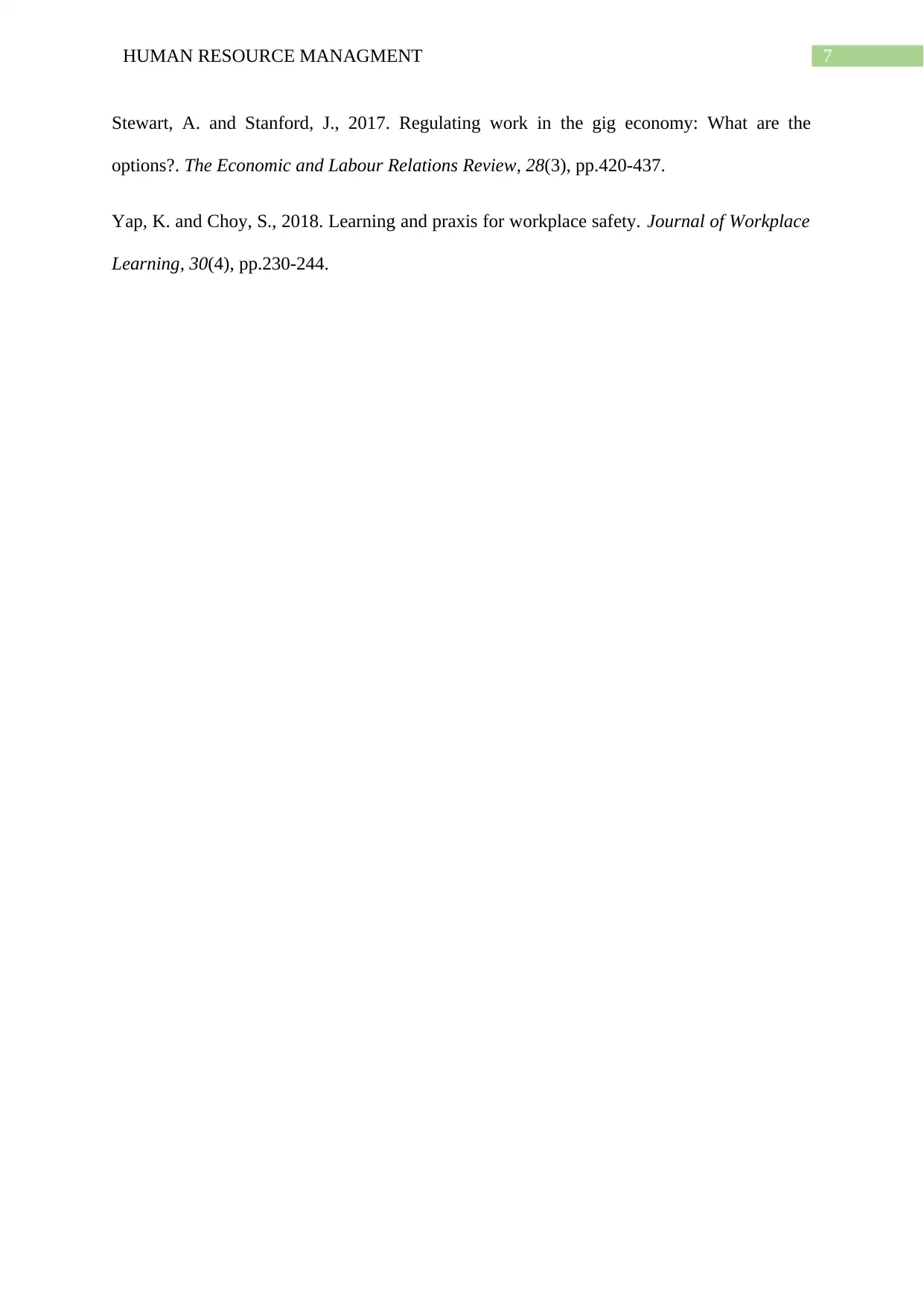
7HUMAN RESOURCE MANAGMENT
Stewart, A. and Stanford, J., 2017. Regulating work in the gig economy: What are the
options?. The Economic and Labour Relations Review, 28(3), pp.420-437.
Yap, K. and Choy, S., 2018. Learning and praxis for workplace safety. Journal of Workplace
Learning, 30(4), pp.230-244.
Stewart, A. and Stanford, J., 2017. Regulating work in the gig economy: What are the
options?. The Economic and Labour Relations Review, 28(3), pp.420-437.
Yap, K. and Choy, S., 2018. Learning and praxis for workplace safety. Journal of Workplace
Learning, 30(4), pp.230-244.
1 out of 8
Related Documents
Your All-in-One AI-Powered Toolkit for Academic Success.
+13062052269
info@desklib.com
Available 24*7 on WhatsApp / Email
![[object Object]](/_next/static/media/star-bottom.7253800d.svg)
Unlock your academic potential
Copyright © 2020–2025 A2Z Services. All Rights Reserved. Developed and managed by ZUCOL.





